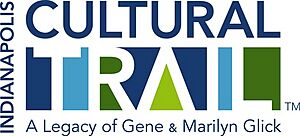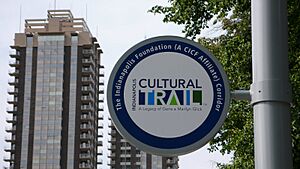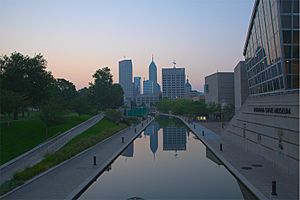Indianapolis Cultural Trail facts for kids
 |
|
| Abbreviation | ICT |
|---|---|
| Formation | 2008 |
| Legal status | 501(c)(3) organization non-profit |
| Purpose | urban linear park; shared-use path |
| Headquarters | 132 W. Walnut St. Indianapolis, IN 46204 |
| Location |
|
|
Executive Director
|
Kären Haley |
|
Main organ
|
Indianapolis Cultural Trail, Inc. |
|
Budget
|
$1 million (2017) |
|
Staff
|
10 (2017) |
|
Volunteers
|
4,500 (2017) |
The Indianapolis Cultural Trail, also known as the Indianapolis Cultural Trail: A Legacy of Gene & Marilyn Glick, is a special path for walking and biking in Indianapolis, Indiana. It's about 8.1-mile-long (13.0 km) and acts like a long park that goes through the city. Many people compare it to other famous bike and walking paths in the U.S. and it has inspired similar projects in other cities.
Contents
What is the Cultural Trail?
The Indianapolis Cultural Trail is a path designed for many different uses. You can easily spot it because it has special colored concrete paths that look the same everywhere. Along the trail, you'll find consistent benches, trash cans, signs, and lights, making it easy to navigate and enjoy.
Where Does the Trail Go?
The Indianapolis Cultural Trail has a main loop in the downtown area and three extra paths, called "spurs."
- One spur goes northeast along Massachusetts Ave.. It connects to the Monon Trail near 10th and Bellefontaine streets.
- Another spur goes southeast along Virginia Ave. It ends where it meets Prospect and Shelby streets in the Fountain Square neighborhood. A special two-way bike path on Shelby Street connects this spur to the Pleasant Run Greenway.
- A short southern spur follows Capitol Ave. This path links the Indiana Convention Center and Lucas Oil Stadium, ending at South Street.
- In 2020, plans began for a two-mile extension. This new part would bring areas like Indiana Avenue and South Street closer to the city center.
The trail also crosses the Canal Walk. This is a 3-mile long (4.8 km) walking loop next to the old Indiana Central Canal.
The Glick Peace Walk
You can find the Glick Peace Walk section of the trail on West Walnut Street. It's located between North Meridian Street and North Capitol Avenue.
Cool Places Along the Trail
Indianapolis has seven special "cultural districts." These areas were first set up in 1999 to highlight unique neighborhoods with important history and cultural spots. This helps with local economic growth. Six of these seven districts are located right along the Indianapolis Cultural Trail:
- Canal and White River State Park
- Fountain Square
- Indiana Avenue
- Market East
- Mass Ave
- Wholesale District
The seventh district, Broad Ripple Village, is about 6.5 miles (10.5 km) north of the trail. You can reach it by using the Monon Trail.
Art Along the Trail
As of 2019, there were nine special art pieces made just for the trail:
- Ann Dancing by Julian Opie
- Care/Don’t Care by Jamie Pawlus
- Chatham Passage by Sean Derry
- Looking Through Windows by Michael Kuschnir
- Moving Forward by Donna Sink
- Poet’s Place
- Prairie Modules 1 & 2 by M12
- Swarm Street by Acconci Studio
- Talking Wall by Bernard Williams
Besides these, the Arts Council of Indianapolis lists 61 other public art pieces near or on the trail.
In August 2018, Citizens Energy Group worked with the Harrison Center to add 20 artist-designed manhole covers along the trail. This project helped people learn more about Indianapolis waterways and a big project called DigIndy.
How the Trail Was Built
The Indianapolis Cultural Trail: A Legacy of Gene & Marilyn Glick officially opened in 2013. It took 12 years of planning and six years to build! This huge project cost $62.5 million. It was a partnership between public groups and private donors. A big part of the funding, $15 million, came from generous people named Gene B. Glick and Marilyn Glick. The trail created 8 miles (13 km) of urban paths for bikes and walkers. It connects the city's cultural districts, neighborhoods, IUPUI, and many important arts, sports, and entertainment places downtown.
Indianapolis Cultural Trail, Inc. also manages and promotes the city's public bicycle-sharing system, called Indiana Pacers Bikeshare. This system has 50 stations and 525 bicycles. The Cultural Trail, working with BCycle and the Herbert Simon Family Foundation, started Pacers Bikeshare on April 22, 2014. It began with 29 stations and 251 bikes. A big expansion happened on September 5, 2019, almost doubling the number of bikes and docking stations. About half of the Cultural Trail's yearly budget of $1 million goes to running this bike-sharing program. The program pays for itself through bike rental fees, yearly memberships, grants, and sponsorships.
Impact of the Trail
The Cultural Trail has had a big positive effect on Indianapolis.
- An early report predicted that the trail would lead to $863 million in new buildings and projects nearby.
- A report from Indiana University in March 2015 found that the value of properties close to the trail increased by $1 billion between 2008 and 2014.
Other important findings from the report include:
- Many more people use the Cultural Trail compared to other paths in Indianapolis.
- People feel safe when they are on the trail.
- Most people use the trail for exercise and fun.
- Businesses located along the trail have hired more employees.
- Property values have gone up along and near the trail.
- Users reported spending money and helping the economy because of their trail use.
The trail has also been great for attracting conventions to the city. It has even inspired other cities in the U.S. and Europe to create similar projects.
See also




